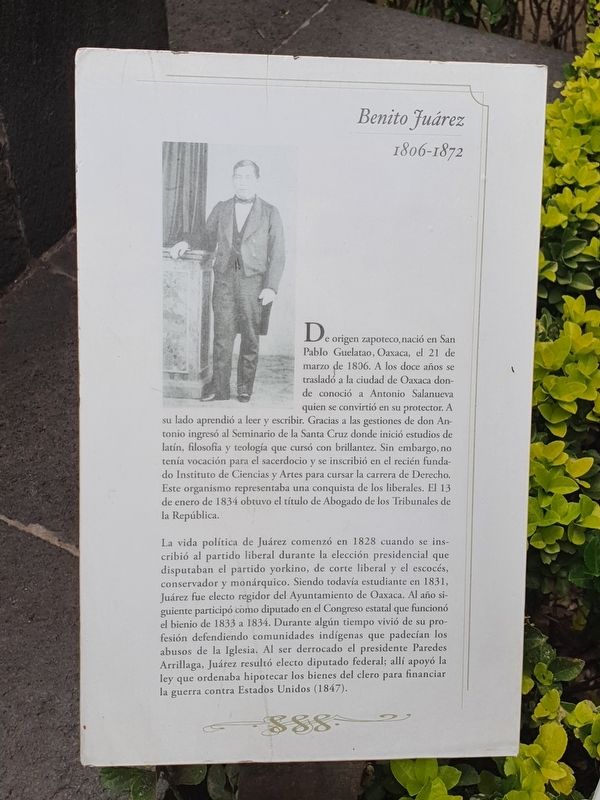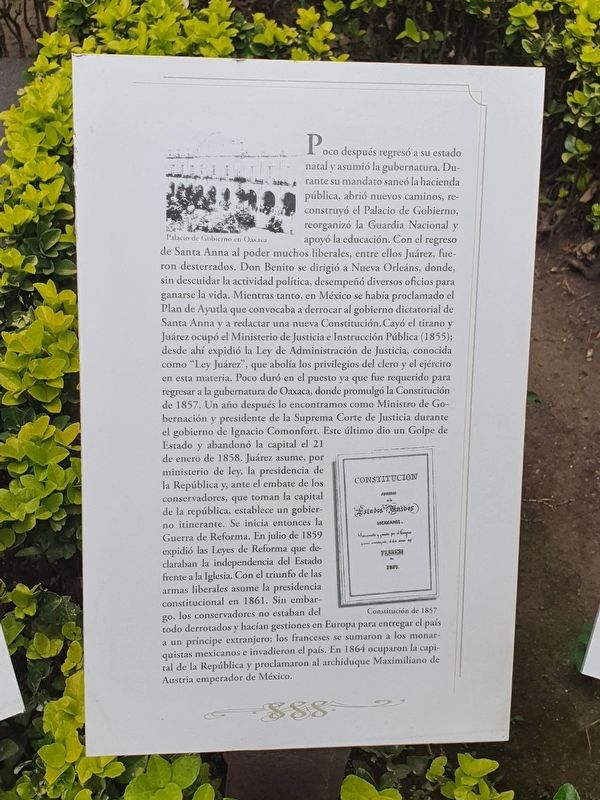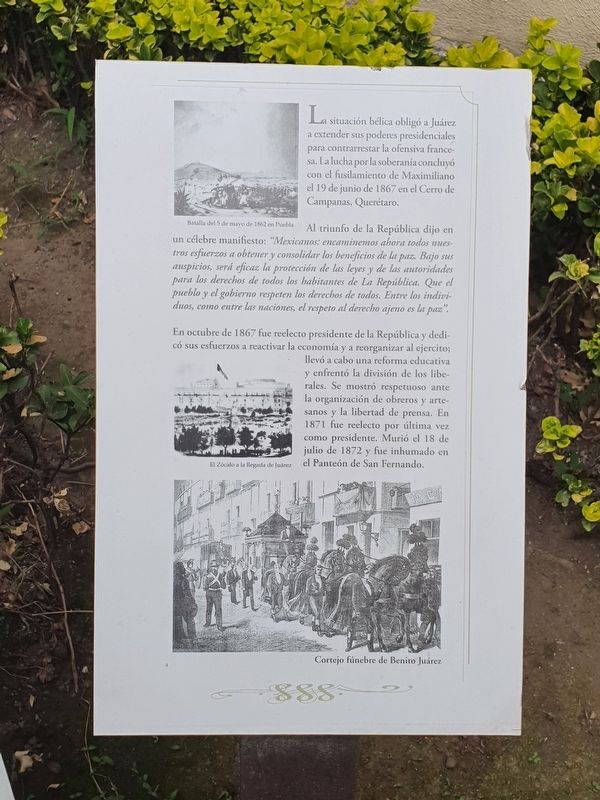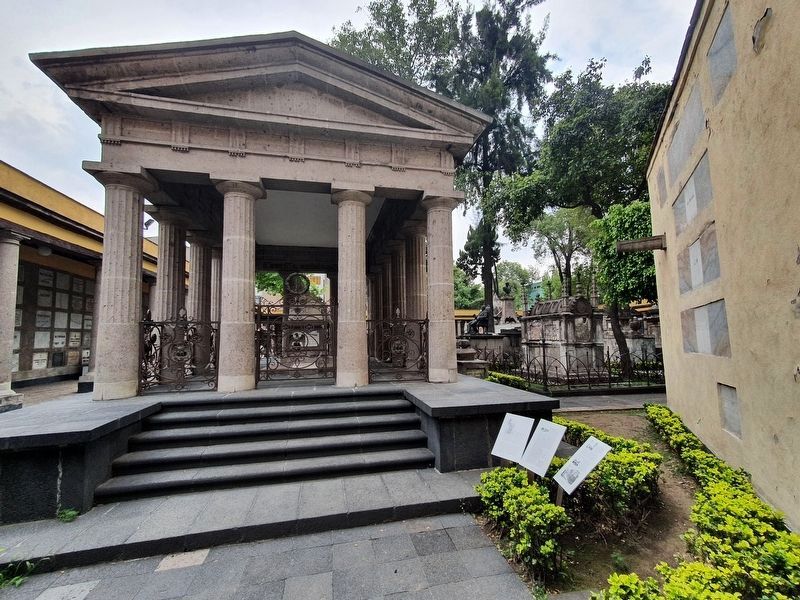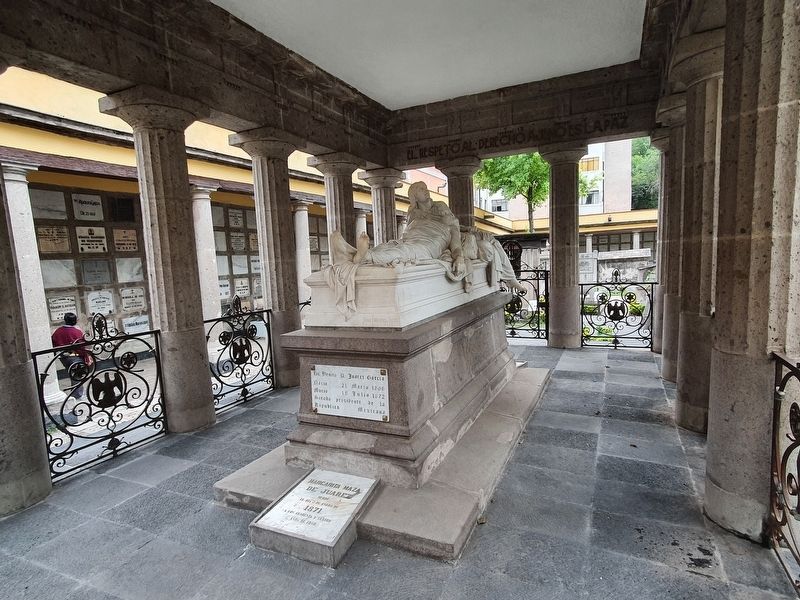Centro Histórico in Ciudad de México, Mexico — The Valley of Mexico (The Central Highlands)
Benito Juárez
1806-1872
De origen zapoteco, nació en San Pablo Guelatao, Oaxaca, el 21 de marzo de 1806. A los doce años se trasladó a la ciudad de Oaxaca donde conoció a Antonio Salanueva quien se convirtió en su protector. A su lado aprendió a leer y escribir. Gracias a las gestiones de don Antonio ingresó al Seminario de la Santa Cruz donde inició estudios de latín, filosofia y teología que cursó con brillantez. Sin embargo, no tenía vocación para el sacerdocio y se inscribió en el recién fundado Instituto de Ciencias y Artes para cursar la carrera de Derecho. Este organismo representaba una conquista de los liberales. El 13 de enero de 1834 obtuvo el título de Abogado de los Tribunales de la República.
La vida política de Juárez comenzó en 1828 cuando se inscribió al partido liberal durante la elección presidencial que disputaban el partido yorkino, de corte liberal y el escocés, conservador y monárquico. Siendo todavía estudiante en 1831, Juárez fue electo regidor del Ayuntamiento de Oaxaca. Al año siguiente participó como diputado en el Congreso estatal que funcionó el bienio de 1833 a 1834. Durante algún tiempo vivió de su profesión defendiendo comunidades indígenas que padecían los abusos de la Iglesia. Al ser derrocado el presidente Paredes Arrillaga, Juárez resultó electo diputado federal; allí apoyó la ley que ordenaba hipotecar los bienes del clero financiar la guerra contra Estados Unidos (1847).
Poco después regresó a su estado natal y asumió la gubernatura. Durante su mandato saneó la hacienda pública, abrió nuevos caminos, reconstruyó el Palacio de Gobierno, reorganizó la Guardia Nacional y apoyó la educación. Con el regreso de Santa Anna al poder muchos liberales, entre ellos Juárez, fueron desterrados. Don Benito se dirigió a Nueva Orleáns, donde, sin descuidar la actividad política, desempeñó diversos oficios para ganarse la vida. Mientras tanto, en México se había proclamado el Plan de Ayutla que convocaba a derrocar al gobierno dictatorial de Santa Anna y a redactar una nueva Constitución. Cayó el tirano y Juárez ocupó el Ministerio de Justicia e Instrucción Pública (1855); desde ahí expidió la Ley de Administración de Justicia, conocida como "Ley Juárez", que abolía los privilegios del clero y el ejército en esta materia. Poco duró en el puesto ya que fue requerido para regresar a la gubernatura de Oaxaca, donde promulgó la Constitución de 1857. Un año después lo encontramos como Ministro de Gobernación y presidente de la Suprema Corte de Justicia durante el gobierno de Ignacio Comonfort. Este último dio un Golpe de Estado y abandonó la capital el 21 de enero de 1858. Juárez asume, por ministerio de ley, la presidencia de la República y, ante el embate de los conservadores, que toman la capital de la república, establece un gobierno itinerante. Se inicia entonces la Guerra de Reforma. En julio de 1859 expidió las Leyes de Reforma que claraban la independencia del Estado frente a la Iglesia. Con el triunfo de las armas liberales asume la presidencia constitucional en 1861. Sin embargo, los conservadores no estaban del todo derrotados y hacían gestiones en Europa para entregar el país a un príncipe extranjero; los franceses se sumaron a los monarquistas mexicanos e invadieron el país. En 1864 ocuparon la capital de la República y proclamaron al archiduque Maximiliano de Austria emperador de México.
La situación bélica obligó a Juárez a extender sus poderes presidenciales para contrarrestar la ofensiva francesa. La lucha por la soberanía concluyó con el fusilamiento de Maximiliano el 19 de junio de 1867 en el Cerro de Campanas, Querétaro.
Al triunfo de la República dijo en un célebre manifiesto: "Mexicanos: encaminemos ahora todos nuestros esfuerzos a obtener y consolidar los beneficios de la paz. Bajo sus auspicios, será eficaz la protección de las leyes y de las autoridades para los derechos de todos los habitantes de La República. Que el pueblo y el gobierno respeten los derechos de todos. Entre los individuos, como entre las naciones, el respeto al derecho ajeno es la paz".
En octubre de 1867 fue reelecto presidente de la República y dedicó sus esfuerzos a reactivar la economía y a reorganizar al ejercito; llevó a cabo una reforma educativa y enfrentó la división de los liberales. Se mostró respetuoso ante la organización de obreros y artesanos y la libertad de prensa. En 1871 fue reelecto por última vez como presidente. Murió el 18 de julio de 1872 y fue inhumado en el Panteón de San Fernando.
Pie de dibujos: Palacio de Gobierno en Oaxaca
Constitución de 1857
Batalla del 5 de mayo de 1862 en Puebla
El Zócalo a la llegada de Juárez
Cortejo fúnebre de Benito Juárez
Of Zapotec origin, he was born in San Pablo Guelatao, Oaxaca, March 21, 1806. At the age of twelve, he moved to Oaxaca City where he met Antonio Salanueva, who became his protector. By his side he learned to read and write and thanks to the efforts of Don Antonio he entered the Seminary of the Holy Cross where he began studies of Latin, philosophy and theology that he studied brilliantly. However, he did not have a vocation for the priesthood and instead enrolled in the newly founded Institute of Sciences
and Arts to study law. This body represented a conquest of the liberals. On January 13, 1834 he obtained the title of Lawyer of the Courts of the Republic.
The political life of Juárez began in 1828 when he registered with the Liberal party during the presidential election disputed by the Liberal Yorkist Party against the Scottish Conservative and Monarchical Party. While still a student in 1831, Juárez was elected alderman of the Oaxaca City Council. The following year he participated as a deputy in the state Congress that operated from 1833 to 1834. For some time he made a living from his profession defending indigenous communities that suffered from the abuses of the Church. When President Paredes was overthrown by Arrillaga, Juárez was elected as a federal deputy; There he supported the law that ordered the mortgage of the assets of the clergy to finance the war against the United States (1847).
Shortly thereafter he returned to his home state and assumed the governorship. During his term he cleaned up the public expenses, opened new roads, rebuilt the Government Palace, reorganized the National Guard and supported education. With the return of Santa Anna to power many liberals, including Juárez, were banished. Benito went to New Orleans, where, without neglecting his political activity, he performed various offices to make a living. Meanwhile, in Mexico the Plan of Ayutla was created that called for the overthrow of the dictatorial government of Santa Anna and for the drafting of a new Constitution. The tyrant fell, and Juárez occupied the Ministry of Justice and Public Instruction (1855); from there he issued the Law on the Administration of Justice, known as the "Juárez Law", which abolished the privileges of the clergy and the army. He did not last long in the position as he was required to return to the governorship of Oaxaca, where he promulgated the Constitution of 1857. A year later he was Minister of the Interior and president of the Supreme Court of Justice during the government of Ignacio Comonfort. The latter staged a coup d'état and left the capital on the 21st. In January 1858 Juarez assumes, through the Ministry of Law, the Presidency of the Republic and, in the face of the onslaught of the conservatives, who take the capital of the Republic, establishes an itinerant government. The War of Reform begins and iIn July 1859 he issued the Reform Laws that declared the independence of the State from the Church. With the triumph of the Liberals he assumed the constitutional presidency in 1861. However, the conservatives were not entirely defeated and made efforts in Europe to hand the country over to a foreign prince; The French joined the Mexican monarchists and invaded the country. In 1864 they occupied the capital of the Republic and proclaimed Archduke Maximilian of Austria Emperor of Mexico.
The war situation forced Juárez to extend his presidential powers to counter the French offensive. The struggle for sovereignty was finally over with the execution of Maximilian on June 19, 1867 in the Cerro de Campanas, Querétaro.
At the triumph of the Republic he said in a famous manifesto: "Mexicans: let us now direct all our efforts to obtain and consolidate the benefits of peace. Under its auspices, the protection of laws and authorities will be effective for the rights of all the inhabitants of the Republic. That the people and government respect the rights of all. Among individuals, as among nations, respect for the rights of others is peace."
In October 1867 he was reelected President of the Republic and devoted his efforts to reactivating the economy and reorganizing the army. He carried out an educational reform and faced the division of the liberals. He was respectful to the organization of workers and artisans and freedom of the press. In 1871 he was re-elected for the last time as president. He died on July 18, 1872 and was buried in el Panteón de San Fernando.
Captions: Governmental Palace of Oaxaca
Constitution of 1857
Battle of May 5, 1862 in Puebla
The Zócalo at the arrival of Juárez
Funeral procession of Benito Juárez
Topics. This historical marker is listed in these topic lists: War, Mexican-American • Wars, Non-US. A significant historical year for this entry is 1806.
Location. 19° 26.353′ N, 99° 8.886′ W. Marker is in Ciudad de México. It is in Centro Histórico. Marker can be reached from Calle San Fernando, on the right. The marker is at the San Fernando Cemetery (Pantéon de San Fernando). Touch for map. Marker is at or near this postal address: C San Fernando 17, Ciudad de México 06300, Mexico. Touch for directions.
Other nearby markers. At least 8 other markers are within walking distance of this marker. Mariano Riva Palacio (here, next to this marker); Vicente Guerrero (here, next to this marker); Martyrs of Uruapan (a few steps from this marker); Juan de la Granja (a few steps from this marker); Isadora Duncan (a few steps from this marker); Mariano Otero (a few steps from this marker); Margarita Maza Parada (a few steps from this marker); Francisco Zarco (a few steps from this marker). Touch for a list and map of all markers in Ciudad de México.
Credits. This page was last revised on February 25, 2023. It was originally submitted on February 25, 2023, by J. Makali Bruton of Accra, Ghana. This page has been viewed 86 times since then and 28 times this year. Photos: 1, 2, 3, 4, 5. submitted on February 25, 2023, by J. Makali Bruton of Accra, Ghana.
